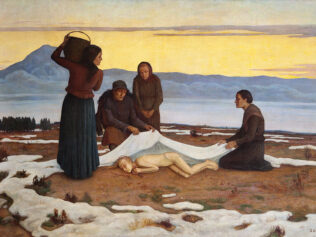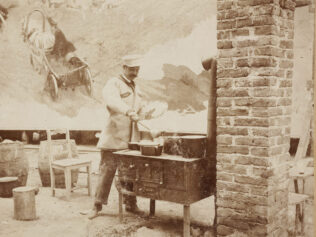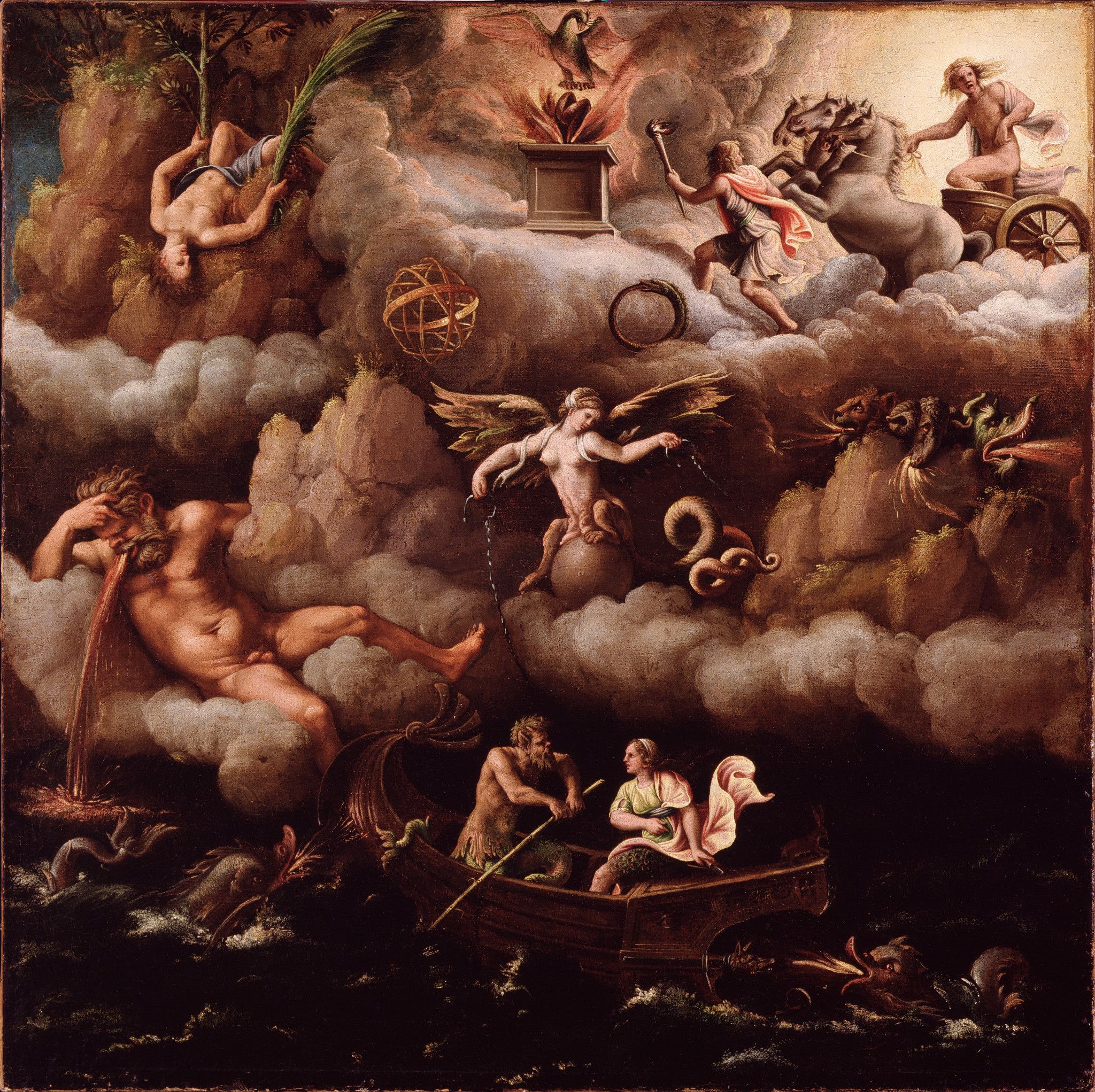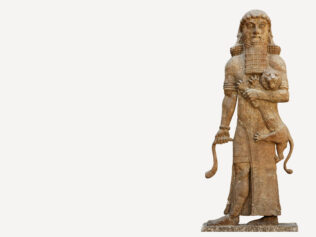
Euphoria, out-of-body experiences, visions too marvelous to describe. These are just a part of the truth of near-death experiences. As it turns out, they don’t always include a tunnel, and there’s not always a light at the end.
Before Raymond Moody’s book, Life After Life, became a worldwide hit, there were far fewer works that described near-death experiences (NDEs). A forerunner on this subject can be found in the Swiss geology professor and alpinist Albert Heim, who lived at the turn of the nineteenth and twentieth centuries. Although he had no formal education in psychology, Heim was a man with wide-ranging interests; he researched subjects including the use of hypnosis, and raised Swiss herding dogs.
One reason for his unusual passions was a dangerous accident that happened to him in the mountains. When he described it to friends who had also fallen off precipices, it turned out that they had experienced similar mysterious “paranormal” states. Heim began to document this kind of story from other climbers, as well as war veterans, bricklayers, workers, and fishermen. Essentially, representatives of professions that often experience serious accidents. Regardless of the type of incident, the stories were very similar. His interlocutors felt that time slowed down, while their minds began to work faster. Those who had experienced such things could recall the most important moments of their lives, even the difficult and painful ones, while at the same time taking lightning-fast action to save their lives and minimize their injuries. The descriptions of these experiences sometimes took up several pages, while the event itself took at most a few seconds. Some heard heavenly music, experienced extraordinary aesthetic impressions and had a religious experience of the sublime. One student Heim studied, who had been saved from a train crash, felt no pain even though he was covered in blood, and heard the words “God is all-powerful.”
People who had similar experiences said their lives were decisively changed. On the basis of his research, Heim reached quite a shocking conclusion: death in an unexpected accident is a positive, pleasant experience.
Great Harmony
The article Heim published in 1892 intrigued psychologists and psychiatrists, but it can’t be said to have achieved popularity comparable with Moody’s bestseller from almost a century later. Even though the latter author’s books are often published alongside esoteric or parapsychological works, he himself didn’t work in these fields. Moody earned a doctorate in philosophy from the University of Virginia, and graduated from the Medical College of Georgia with a specialization in psychiatry. The field in which he became a well-known expert was one he heard about by coincidence from a teacher. Later, after Moody himself started teaching philosophy, one of his students told him about their grandmother’s experience following a very difficult operation. Moody started to learn about other stories, and doctors he knew would send him patients who had undergone resuscitation. The material he gathered this way led to the publication in 1975 of his famous Life After Life.
On the basis of 150 accounts from people who had undergone clinical death, and those who had had brushes with death, the researcher drew puzzling conclusions. Just like Heim, Moody recognized a pattern of experiences that appeared repeatedly, despite differences in the subjects’ education, gender, and origins.
The pattern looks like this: everything begins with a powerful, unpleasant auditory impression—a ringing or rushing—combined with the feeling of moving through a dark tunnel. Sometimes people experience being outside their bodies, while also being able to perceive their surroundings. After the initial shock, the conscious mind begins to get a grasp on the situation. Later, you can feel the presence of supernatural beings, or deceased family members or friends. Despite the joy, harmony and excitement they experience, the dying person realizes they have to return to their body. Not all of it can be described: language can’t communicate the richness of these events. The elements mentioned here can be found in many accounts, but they differ in the frequency and order in which they appear. Moody said the intensity of NDE visions is correlated with the threat: the closer to real death, the fuller the experience. The philosopher adds, frankly, that he also carried out interviews with people who had been in a state of clinical death and didn’t experience anything similar (or simply didn’t remember).
Looking Down on Yourself
When the American cardiologist Michael Sabom read Life After Life, he decided the author was either lying or being lied to. He accused the book of lacking methodology, statistics, names, and medical context. He decided to study NDEs for himself and find a rational explanation for them. In his books, he frequently mentions the sudden descent of a pregnant silence when, with no warning, he asked patients what they saw during an operation. It wasn’t easy to gain their confidence, but after 150 interviews and five years of research, Sabom recognized that he couldn’t find a simple explanation for these phenomena.
The research he published on this subject gained recognition because of his methodology. Not only did it include detailed documentation, tables and statistics, it also considered hypotheses that explain the phenomena, such as temporary hypofunction of the frontal lobes, a release of endorphins, or the effects of medications. The doctor’s interviews with people who had suffered heart attacks, or for whom an operation was interrupted, didn’t just confirm Moody’s conclusions; they also brought in new observations. For example, Sabom noted that a higher percentage of those who experienced a life-threatening accident and didn’t have NDEs were people who had heard of the phenomenon earlier. What’s most amazing in Sabom’s Recollections of Death, are the precise descriptions of the phenomenon of autoscopy, or seeing oneself from outside. The patients he spoke with could describe precisely the progress of their operations. Sabom checked their medical knowledge, verified how long they had been in the surgery ward, and took into account whether they had watched television programs on the subject. The material he gathered indicated that his research subjects didn’t have specialized knowledge of resuscitation procedures, e.g., they didn’t know how a defibrillator was used. Even so, those who had had autoscopic NDEs described events without gross errors.
Blinding Light
One of the cases Sabom analyzed in Light and Death gained great attention. It’s the story of the thirty-five-year-old singer Pam Reynolds, who had to undergo an exceptionally complicated brain operation, requiring deep hypothermic circulatory arrest. Her temperature was lowered to 15°C (59°F); she wasn’t breathing on her own, her heart stopped, and blood stopped flowing to her brain. By all medical criteria she was dead, which was also confirmed by EEG and ABR tests showing a lack of brain activity.
After the operation, Reynolds described her experience of being outside her body (even sitting on the shoulder of the surgeon operating on her), and remembered the equipment the doctors used and even the music that was on the radio. The accuracy of her account was confirmed. The singer’s experiences weren’t reduced only to being a witness of her operation. She described a paradoxical feeling: she found herself in a tunnel which also was not a tunnel; she saw deceased relatives beyond a “blinding light;” she heard the voice of her dead grandmother calling her, while other departed relatives didn’t want her to move toward the light. Reynolds wanted to join them, but at the same time, she wanted to return to her body and her earthly life—she remembered that she had children to raise. Reynolds stressed that during her NDE she had an extraordinary, heightened quality of perception and awareness. Her case was confirmed by a correlation noted by the author of Life After Life between the closeness of death and the intensity of the NDE.
Sabom wasn’t the only person who continued Moody’s discoveries. Numerous researchers investigated statistical questions concerning NDEs. An article by the psychiatrists Glenn Roberts and John Owen, “The Near-Death Experience,” published in the British Journal of Psychiatry, showed that half of the people who went through clinical death had NDEs. Additionally, the scientists stressed that their occurrence isn’t correlated with age, sex, education, occupation, marital status, or religious faith.
Interesting work on NDEs in children by Nancy Evans Bush showed that younger patients in similar conditions also experience encounters with a supernatural being, but they don’t see events from their lives; however, they do have a vision of light twice as often as adults. The psychiatrist Russell Noyes Jr. gives a list of the most common consequences of NDEs: reduced fear of death, insensitivity to pain, stronger faith in an afterlife, a feeling of “being chosen” and a “destiny” that can’t always be precisely described, which was communicated by the supernatural being.
The Dark Side
Toward the end of the 1970s, the psychologists Stanislav Grof and Joan Halifax, during their work with cancer patients, noted cases of NDEs that weren’t positive: their visions included “hungry spirits,” “fire” and “hellish beings.” These perceptions were confirmed by other publications from independent researchers.
This important conclusion knocked down a certain hypothesis on NDEs, based on the Freudian concept of repression. Under the influence of great stress caused by the threat of death, the mind was thought to create an escapist fantasy—a type of hallucination, which covers up the shocking truth about the end of life. This theory doesn’t hold up under criticism because of the cases of NDEs that turn out to be terrifying experiences.
Some believe that experiences from the edge of death can reveal the essence of reality, “the truth about yourself and the world.” So would that mean we’re dealing with a “true hallucination,” and thus, something internally inconsistent? Grof was just as happy to use psychoanalytical concepts in the context of NDEs, often explaining the symbolism seen during the tunnel as a memory of birth. But some researchers rejected this explanation: first, the birth canal isn’t like a tunnel; second, the depth of the experiences that accompany NDEs can’t be explained simply by a memory of birth (the possibility of which is dubious in the case of the mind of a newborn, with no ability to remember); third, those who were born by cesarean section experienced NDEs similar to those of people who were born naturally.
Deity with a Book
The accounts of NDEs that come from all over the world add up to an extraordinary collection, the best example of which is the website nderf.org, founded by the Near-Death Experience Research Foundation. Regardless of whether we read about the experiences of an American child who suffered severe anaphylactic shock, or an adult Australian after a car accident, we always encounter similar motifs. Many believers in these phenomena have stressed their universality, but the cases that are described come exclusively from Western culture, specifically American culture.
Still, there’s no shortage of fascinating research on NDEs among people who come from other cultures. In Satwant Pasricha and Ian Stevenson’s pioneering study Near-Death Experiences in India, we can read about the surprising conclusions that arise from 16 cases of NDEs described in that country. Although the sample is small, it’s big enough to indicate certain fundamental differences. In these versions, motifs often appear that didn’t occur at all in the American descriptions, especially the presence of “a supernatural being with a book.” No Indian experienced exiting their body and observing it from above. After near-death experiences, people from Western cultures often returned to their bodies out of love for their living family members; this was not noted at all in India. NDEs in that country are most often seen as mistakes. The supernatural figure takes the soul to another reality (a motif which also appears rarely in Western NDEs), but suddenly realizes that they weren’t the intended person, and sends them back to the living. The researchers connected this supernatural figure with the deity Chitragupta. In Indian art, this deity is portrayed with a book in which it writes down the names of the dead. Some cases of NDEs are also interpreted in the context of local mythology, as a meeting with the lord of death, Yama. In later works, Pasricha says that in decades of work on NDEs in India, she never encountered the tunnel motif.
Research in that country indicated that differences in near-death experiences appear even between Northern and Southern India. That means the content of an NDE is, to some degree, dependent on the culture of the person experiencing it, though just as striking are the similarities between cultures, e.g. encounters with supernatural beings.
In Ireland and Tibet
Research on NDEs provides a different perspective on the history of religion—on the possible genesis of concepts such as the souls of the dead, judgment on the living and our imagination of supernatural beings and paradise. Ioan Petru Couliano, a student of Mircea Eliade, in Out of this World, a comparative study of visions of the afterlife, expressed the suspicion that certain religious imaginings come from altered states of consciousness. The visions of the afterlife in Jewish and early Christian apocalypticism most likely come from dreams; in ancient Iranian traditions, a clear influence of hallucinogens was visible; in turn, Greek and medieval Christian mysticism, the scholar says, show strong connections precisely with near-death experiences.
Adopting this perspective allows a new reading of many religious messages. One particularly popular work from the European Middle Ages was the twelfth century text, Tondal’s Vision. Written by an Irish monk, the text tells of a knight, the titular Tondal, who, after falling off a horse, lies motionless for three days. During that time, an angel in the form of starlight is said to have taken his soul and showed him a marvelous, incredible reality of heaven and hell, a vision of the fountain of life and the fields of Purgatory. After returning to the living, Tondal gave all his wealth to the needy and joined a monastery. Sound familiar?
For a long time, researchers have also pointed out the amazing connections between descriptions of NDEs and the content of the famous Tibetan Book of the Dead, one of a dozen scriptures known to Tibet scholars that contain collections of teachings for the dying, which (if the person isn’t an advanced yogi) should be recited forty-nine days after what we in the West generally call death. The ritual is meant to help the soul in salvation or a favorable reincarnation. Here, we can see the assumption that there exists a consciousness (a soul? a mental body?) present in the body despite the lack of physical signs of life. The text gives a detailed account of what happens to the consciousness after death: it describes the movements made by the soul, understood as “luminous breath,” while in the “intermediate state.” We also learn the visions it will experience of light, Buddhas, supernatural beings. What’s exceptionally interesting is that one of the teachings that flows from the Tibetan Book of the Dead is that all visions are simply an act of the mind, and understanding this truth is a condition of salvation.
Tricks of the Brain?
Many teachers try to explain NDEs in a similar way (though of course, not for the purpose of salvation). They say it’s a specific action of the brain caused by defined neurophysiological factors. One of the popular, naturalistic explanations refers to anoxia, a lack of oxygen in the brain. Observations and descriptions of blackouts—during which a the body’s pilot loses consciousness, when a gravitational disturbance makes the heart unable to pump blood to the upper parts of the body—allow us to state that a dying brain behaves in the precise way that’s characteristic of an NDE: causing euphoria, an impression of leaving the body, and visions.
The tunnel that is characteristic of NDEs is said to come about as a result of the neuronal discharges created at that time. But explanations of this type meet resistance from some scholars. The neuropsychiatrist Peter Fenwick stated that during brain disorders, memories and perception cannot be described as clearly as in NDEs. And note that, during an NDE, we are dealing not with chaotic visions, but most often with internally structured imaginings of a specific religious-mystical nature.
But how do you get from a lack of oxygen to visions of supernatural beings? And wouldn’t these theories lead to the conclusion that for a person to experience the highest possible sensations . . . they should strangle themselves and damage their brains? As Grof correctly points out in his book The Ultimate Journey, such hypotheses don’t explain where the transcendental nature of such experiences comes from, or the nostalgia for them. When the brain is dying, why does it create visions of light or cities of light; why does the body fall into euphoria and these ecstatic images appear before people’s eyes—images which they can’t describe?
A Question about Life after Death
Now let’s try to take on the most important question: do NDEs confirm the existence of life after death? Moody responded in the negative, but among researchers on this phenomenon he’s in the minority. The question must be reformulated: do NDEs really confirm the independence of consciousness from brain function? If that’s the case, consciousness as the soul could last after the body’s death.
Sam Harris, a well-known American intellectual and one of the representatives of the new atheism, analyzes this question in his book, Waking Up. He notes that the available medical data don’t lead to an unambiguous conclusion about brain death. After all, an NDE is still an experience of being near death, not beyond it. Interestingly, on this point, Harris’s views line up with what Sabom wrote when analyzing the case of Reynolds—affirming that, regardless of what the medical devices show, death is an elusive process, not one that can be isolated to a particular moment.
For Grof, the ability to observe your own operation or leave your body constitutes evidence of the soul’s independence from the brain and testimony to the ability of the consciousness, which does what the brain itself cannot. Harris doesn’t agree with these conclusions: even if experiences such as leaving the body are true, they don’t prove anything. In this case, we would be dealing at most with some form of extrasensory perception: astonishing, but not attesting to life beyond the grave or to the independence of consciousness from the brain. Since we’re not certain that, at the time of these sensations, the brain was inactive, we must still assume it participates.
Harris also commented on the famous case of Eben Alexander, who described his near-death experience in the bestseller Proof of Heaven: A Neurosurgeon’s Journey into the Afterlife. He stressed the factual errors in Alexander’s book and also noted the surprising similarity between the doctor’s account and descriptions of the state after taking DMT (the compound present in ayahuasca, ritually used in Amazonia). This connects Harris with researchers such as Grof, who also noted surprising congruences between the descriptions of NDEs and the mental states caused by the use of psychoactive substances. In these borderline states, the human body was said to create particles that work the same way as hallucinogens. But again: why does this happen?
Worlds Colliding
Whatever their cause, NDEs remain a psychological fact. It’s a mysterious phenomenon, which we can’t fully explain, but which has great influence on people’s lives. We can be tempted to reduce it to the functioning of the mind, to something that only happens in our internal world, with no connection to the “real” one.
But as Couliano notes, the problem is that the fierce opposition of these two worlds is not at all obvious philosophically. What we call the “internal world,” e.g. memories or the forms of our fantasies or imaginations, comes from “the outside,” while what we call the “external world” is a reflection of what we experience in our “interior.”
So if we assume that an NDE is only a creation of the human mind, the great question still remains: what, after all, is the human mind?










